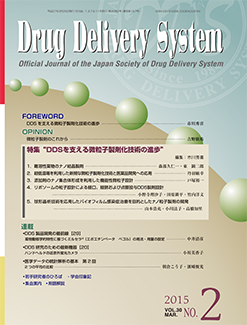Volume 30, Issue 2
Recent progress in pharmaceutical technologies for particulate drug delivery systems
Displaying 1-12 of 12 articles from this issue
- |<
- <
- 1
- >
- >|
[Feature articles] “Recent progress in pharmaceutical technologies for particulate drug delivery systems” Editor:Hideki Ichikawa
-
2015Volume 30Issue 2 Pages 89
Published: March 25, 2015
Released on J-STAGE: June 25, 2015
Download PDF (221K) -
2015Volume 30Issue 2 Pages 90
Published: March 25, 2015
Released on J-STAGE: June 25, 2015
Download PDF (230K) -
2015Volume 30Issue 2 Pages 92-99
Published: March 25, 2015
Released on J-STAGE: June 25, 2015
Download PDF (677K) -
2015Volume 30Issue 2 Pages 100-110
Published: March 25, 2015
Released on J-STAGE: June 25, 2015
Download PDF (1766K) -
2015Volume 30Issue 2 Pages 111-120
Published: March 25, 2015
Released on J-STAGE: June 25, 2015
Download PDF (1130K) -
Advanced particle design of liposomes for drug delivery in oral, pulmonary and ocular administration2015Volume 30Issue 2 Pages 121-128
Published: March 25, 2015
Released on J-STAGE: June 25, 2015
Download PDF (1211K) -
2015Volume 30Issue 2 Pages 129-138
Published: March 25, 2015
Released on J-STAGE: June 25, 2015
Download PDF (1325K)
[Serial] Front line of DDS development in pharmaceutical industries
-
Optimization of dosing regimen for MIRCERA® (Epoetin beta pegol) based on pharmacokinetic properties2015Volume 30Issue 2 Pages 139-144
Published: March 25, 2015
Released on J-STAGE: June 25, 2015
Download PDF (409K)
[Serial] Recent advancements in instruments used for DDS research
-
2015Volume 30Issue 2 Pages 145-148
Published: March 25, 2015
Released on J-STAGE: June 25, 2015
Download PDF (670K)
[Serial] Fundamentals of statistical analysis in biomedical research
-
2015Volume 30Issue 2 Pages 149-158
Published: March 25, 2015
Released on J-STAGE: June 25, 2015
Download PDF (1032K)
“Young square”(mini review)
-
2015Volume 30Issue 2 Pages 160-161
Published: March 25, 2015
Released on J-STAGE: June 25, 2015
Download PDF (620K) -
2015Volume 30Issue 2 Pages 162-163
Published: March 25, 2015
Released on J-STAGE: June 25, 2015
Download PDF (448K)
- |<
- <
- 1
- >
- >|
